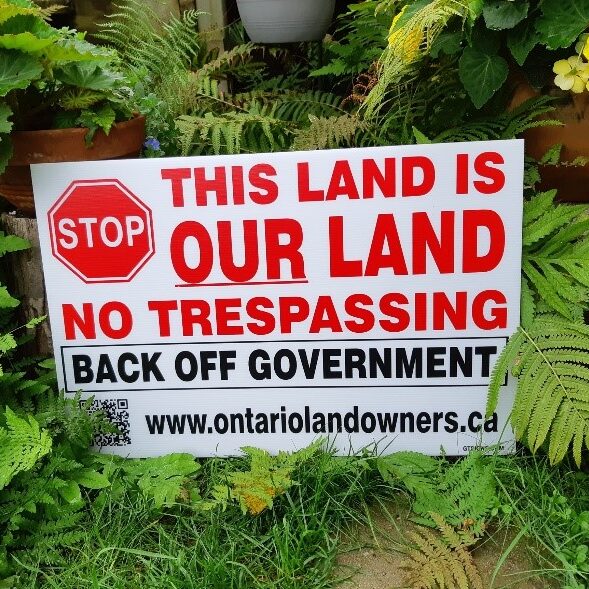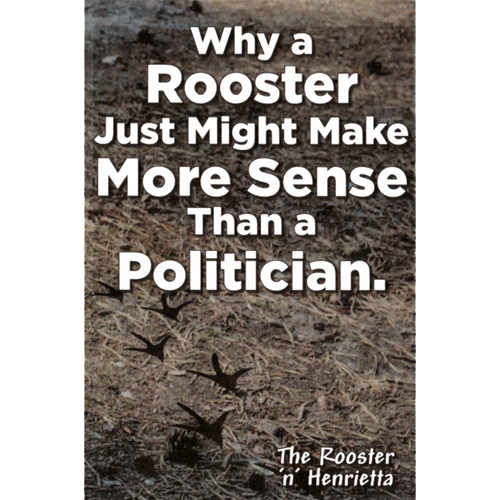Illegal Bullying By Conservation Authorities Castigated By High Court by Gord Turcotte
- 2016-02-01
- By admin
- Posted in Latest News
“[It] is not akin to studying the impact of fluttering butterfly wings in Mongolia on flooding in [Ontario]” – Superior Court of Justice
Alex and Tania Gilmor of Shelburne, Ontario are heroes. They are heroes because they maintained the fortitude and wherewithal to battle the unjust persecutions that many Ontario residents and businesses now suffer at the hands of our current government.
The now regimented clerics of our Conservation Authorities continue to sow religious persecutions across the province to the detriment of people like the Gilmors and all Ontarians. However, with the conclusion of this case we may all owe the Gilmors a great deal of gratitude.
Over the past six years, the Gilmor’s file wound its way through the legal system to the Ontario Superior Court of Justice (Divisional Court). Once there, the higher Court was decisive in granting their appeal. The high Court reversed a previous decision by the Mining and Lands Commissioner (Tribunal Court) to uphold an earlier decision by the Nottawasaga Valley Conservation Authority (NVCA) to deny the Gilmors permission to build a home on their land. After six long years and thousands of dollars wasted, the Gilmors are now free and clear of the clutches and zealous ilk of the Conservation Authority (regardless, they must still complete the building permit process).
This is a landmark case not only because it was decided in Superior Court, but also for several notable reasons. First, the Gilmors did not back down from the initial denials because they knew that the NVCA was operating outside of the law and the Tribunal erred in law and that error could only be corrected at Superior Court. This is notably important because many people do not understand the differences between the levels of our Court system until they are caught up in it.
Most cases between landowners and Conservation Authorities are heard in Provincial Offences Court. These cases stem from charges laid by a Conservation Authority for infractions under its own published ‘regulations’ that are ‘committed’ by the landowner.
However, these regulations are intended for the Conservation Authorities own statutory ‘objects’, much like an Ontario Corporation sets its own bylaws and policies under the Corporations Act to manage its own business affairs.
At Provincial Offences Court, a Justice of the Peace (JP) examines the published regulations and compares them with the facts at hand (amongst other considerations). It is important to point out that a JP is not a trained lawyer or Judge and he or she makes decisions based on the criteria before the Court. In this setting, these rulings will generally favour the Conservation Authority.
Discouraged and disenfranchised at trial, the landowner accepts the lower Court’s decision, believing it has moral authority and force of law. Thus, the case goes no further and this process generates a growing body of jurisprudence for all Conservation Authorities. Here’s where things get legally challenging.
Provincial Offences Court does not have the power and authority (the legal jurisdiction) to review or rule on whether or not the regulations themselves are ‘correct, appropriate or reasonable’ (points of law).
However, the Superior Court makes no mistake:
“…the Tribunal erred in interpreting the regulatory framework under which it was operating. I have found the decisions both incorrect and unreasonable…”
Given the lower Court’s narrow jurisdiction, naivety of the landowner and growing jurisprudence, the Conservation Authorities utilize this system to expand their own powers and authority. And as is now exposed by the Gilmor case, all Conservation Authorities have been expanding their powers and authorities beyond what is legislated by statute in the Conservation Authorities Act (CAA) and other legislation. Embezzlement can only be dealt with in a Court of law before a Judge. The Gilmors pursued this.
This is also a landmark decision for what is contained in the Court’s reasons for allowing the appeal. Littered throughout the evidence and proceedings, the Superior Court uncovered a regime of taxpayer-funded bullies running around Ontario “expropriating” property rights from otherwise law-abiding Ontarians. The methodology used by the Authority is covert: deny permission to the landowner to develop his/her property for reasons other than what is provided for by statute. For instance, in a case cited in Gilmor, the Superior Court previously discovered that:
“The Tribunal itself has on different occasion characterized this as a “subtle form of expropriation”’ – (Junker v. Grand River Conservation Authority)
Although the CAA does contain provisions for powers to expropriate title to land, those powers are subject to the Expropriations Act, which first requires statutory consent from the governing body. Make no mistake, a Conservation Authority is not the government nor is it an agency thereof. It is now an independent service provider.
Regardless, these “subtle expropriations” are not over title to land, but to the rights to use of it. This illegal bullying is condoned through the PPS (Provincial Policy Statement) and mandated by zealot administrators within government and the Conservation Authorities. However, these are administrative policies, not laws.
In Junker v. Grand River Conservation Authority, the Superior Court states:
“…Government policies are not, however, law. By adopting these policies, an authority cannot acquire a jurisdiction greater than it is given by statute. Nor can an authority use the policy statements to expand on its objectives as set out by legislation…”
And in the Gilmor case, the Court confirms that:
“… Provincial and NVCA policy statements…do not have the force of law…”
And if ‘illegal expropriation’ of property rights was not enough, the Superior Court further found that:
“Authorities have been taking risk of life into account in refusing permission to build. This is beyond their authority. That all authorities seem, without challenge, to use concern for risk of life as a reason for refusing permission is amazing. They, clearly, do so without authority…In this case…safety was used…to impose a blanket ban on development…that is itself without statutory mandate…”
In other words, our current government, deploying the clergy of the Conservation Authorities, use any means necessary to ‘expropriate’ use of land. Except that, under the Expropriations Act, compensation at marketable value must be given to the expropriated party. And again, make no mistake – the marketable value of any land is its use. Here, the Court notes:
“…Land use restrictions of the sort imposed by the NVCA Regulation can impair or even sterilize land from most uses.”
However, this government offers no compensation to the affected Ontarians and adds insult to injury by using the landowner’s own tax dollars to mount these illegal cases that are in fact not expropriations, but extortions. This behaviour has become the de facto standard in our new and improved Ontario. In Junker the Court concluded:
“…there is reason to be vigilant that such a significant impairment of property rights is carefully exercised within the bounds of proper statutory authority.”
Further on in the Court’s examination of the Gilmor case, a mandate to prohibit landowners from exercising their rights to their land became clear:
“To the extent that there was any discussion by either the Tribunal…or the NVCA’s expert…that the present case would set a bad precedent for future developments…”
Obviously, there is some administrative policy at play that is hidden from public scrutiny. The Court goes on to conclude:
“This is a far cry from studying the actual impact of this actual development…The only expert who actually did site-specific measurements was the Gilmor’s and his evidence was not contradicted…Had there been a bona fide concern…The NVCA did not pursue the matter.”
So, regardless of any evidence at hand, any proposed solution or anything else, the Conservation Authority will deny permission because that’s what they now do.
In a nutshell, not only does this government extort property rights, but it also extorts the economic benefits our communities and families would receive from what the Court classified as “benign” developments, such as building a home.
Finally, this decision is precedent setting because the Gilmors were awarded costs by the Divisional Court. Interestingly, the Court acknowledged the award at the higher end of the spectrum for a total of $33,175. The awarding of costs becomes even more significant considering the Conservation Authority was denied costs at both the Tribunal Court and again at Divisional Court. Regardless, this decision and award should instruct all Conservation Authorities to purge themselves of all self-serving fanatics on their payrolls and get back to the basics of science, managing their statutory objects and respecting the taxpayers they serve.
Going forward, the award of costs in this case may prove to be the most significant tool for landowners. This is because Ontario now has a binding decision instructing the Conservation Authorities to bear the costs of their own administrative behaviours and policy misinterpretations:
“…the Tribunal’s reasons indicate that it did indeed proceed from an unreasonable and fundamentally erroneous interpretation of the governing NVCA Regulation.”
These costs will in turn get passed back to the taxpayer, which in turn should instruct the government to curtail municipal funding of Conservation Authorities.
However, there is one disturbing caveat. The Wynne government is currently reviewing the Conservation Authorities Act with the goal of “updating and enhancing” it. Given their track record of administrative policy and of producing more legislation than any other government in history, this likely means that they intend to legalize the extortion of property rights in a revised Conservation Authorities Act. We can only hope I am wrong about this, but as the Superior Court instructed, we need to stay vigilant.
The important thing to remember is that the Conservation Authorities are no longer the government, nor are they an agency thereof. They are now an independent service provider similar to Ducks Unlimited. However, as a legacy agency of the Ministry of Natural Resources, they continue to be mandated by the Provincial Policy Statement and funded by the taxpayer.
It’s no wonder they are so fundamentally screwed up. In effect, Conservation Authorities are now a political arm of the governing Liberal Party of Ontario, paid for by all of us.
Search:
Categories
Archives
- April 2024
- January 2024
- December 2023
- November 2023
- August 2023
- July 2023
- June 2023
- May 2023
- April 2023
- March 2023
- February 2023
- January 2023
- December 2022
- November 2022
- October 2022
- September 2022
- August 2022
- July 2022
- June 2022
- May 2022
- April 2022
- March 2022
- February 2022
- January 2022
- December 2021
- November 2021
- October 2021
- September 2021
- August 2021
- July 2021
- June 2021
- May 2021
- April 2021
- March 2021
- February 2021
- January 2021
- December 2020
- November 2020
- October 2020
- September 2020
- August 2020
- July 2020
- June 2020
- May 2020
- April 2020
- March 2020
- February 2020
- January 2020
- December 2019
- November 2019
- October 2019
- September 2019
- August 2019
- July 2019
- June 2019
- May 2019
- April 2019
- March 2019
- February 2019
- January 2019
- December 2018
- November 2018
- October 2018
- September 2018
- August 2018
- July 2018
- June 2018
- May 2018
- April 2018
- March 2018
- February 2018
- January 2018
- December 2017
- November 2017
- October 2017
- September 2017
- August 2017
- July 2017
- June 2017
- May 2017
- April 2017
- March 2017
- February 2017
- January 2017
- December 2016
- November 2016
- October 2016
- September 2016
- August 2016
- July 2016
- June 2016
- May 2016
- April 2016
- March 2016
- February 2016
- January 2016
- December 2015
- November 2015
- October 2015
- September 2015
- August 2015
- July 2015
- June 2015
- May 2015
- April 2015
- March 2015
- February 2015
- January 2015
- December 2014
- November 2014
- October 2014
- September 2014
- August 2014
- July 2014
- June 2014
- May 2014
- April 2014
- March 2014
- February 2014
- January 2014
- December 2013
- November 2013
- October 2013
- September 2013
- August 2013
- June 2013
- April 2013
- October 2012
- May 2012
- September 2011



